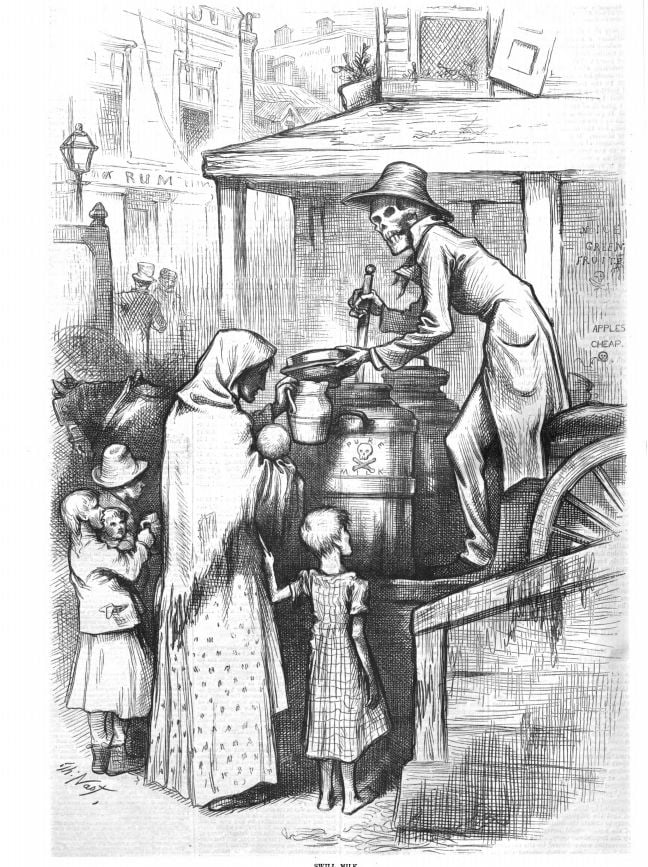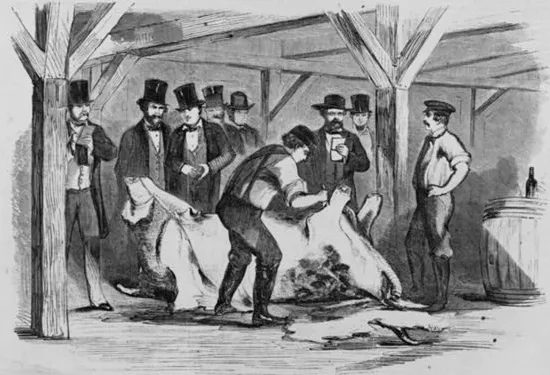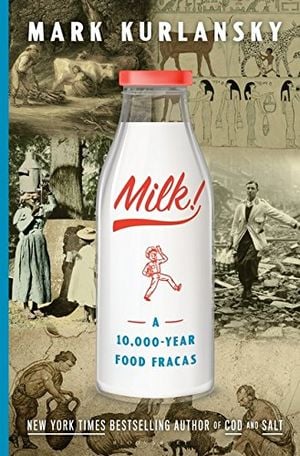The Surprisingly Intolerant History of Milk
A new book provides an udderly fascinating chronicle of the controversial drink
/https://tf-cmsv2-smithsonianmag-media.s3.amazonaws.com/filer/a8/fa/a8fa07d7-d2c4-46e4-9218-19a6d13464a2/3a11348r-wr2.jpg)
On May 8, 1858, Frank Leslie’s Illustrated Newspaper ran a scandalous article on a seemingly benign topic: milk. In a 5,000-word expose, the paper characterized a group of Brooklyn and New York distilleries as “milk murderers” who had distributed “liquid poison” to the unsuspecting masses.
“For the midnight assassin, we have the rope and the gallows; for the robber the penitentiary; but for those who murder our children by the thousands we have neither reprobation nor punishment,” wrote the reporter. “They are not penal villains, but licensed traders, and though their traffic is literally in human life the Government seems powerless or unwilling to interfere.”
Sold by firms hoping to maximize their profits, so-called “swill milk” came from dairy cows that were fed the steaming remains of grain distillation. These cows lived in nearby stables amid miserable conditions–most only survived for a few months–and produced a sickly, bluish milk. To mask this ghastly color, the distilleries added chalk, eggs, flour, water, molasses, and other substances. Local distributors then purchased this toxic concoction from the distilleries and brazenly marketed it as “Pure Country Milk.”
The mendacity of breweries and their willingness to take advantage of young children and their families no doubt contributed to the dramatic and theatrical flair of Leslie’s reports. But as Mark Kurlansky points out in his new book Milk!, the controversy is just one episode among many in milk’s long history. Indeed, for Kurlansky, no food invites more clamorous debate.
Milk!: A 10,000-Year Food Fracas
Mark Kurlansky's first global food history since the bestselling Cod and Salt; the fascinating cultural, economic and culinary story of milk and all things dairy--with recipes throughout.
“We’ve been arguing about these issues for 10,000 years,” Kurlansky says. “In a lot of cases, it’s because there’s not a hard answer… there’s a conflict of values.”
And argue, they did: In subsequent reporting, Leslie’s alleged that “the deaths of two-thirds of the children in New York and Brooklyn could be distinctly traced to the use of impure milk” and the normally restrained New York Times wondered how “the 8,000 children that died last year from the poison of swill milk” could not spur public health officials and local leaders into action.
It soon became clear that New York wasn’t the only city with problems: Thousands of children from Boston to Chicago to San Francisco died each year from the contaminated swill. Public outcry from these revelations eventually led many distilleries to close their deleterious dairies, or, at the very least, clean up their operations.
The drama was also magnified by the fact that raw milk was just becoming popular. For most of history, humans weren’t interested in the direct consumption of animal milk. Instead, the early milkers of the fertile crescent transformed it into sour yogurt, butter and cheese; the hot climate caused milk to quickly spoil.
Even so, milk was a vital symbol in the mythology of the Sumerians, Greeks and Egyptians. The Fulani of West Africa believed that the world started with a single drop of milk, and in Norse legend, a cow made from thawing frost sustained the world in its earliest days. As Kurlansky points out, Milk is even written into the story of our cosmos–our galaxy, after all, is called the Milky Way.
But even with these deep cultural connections, milk held a peculiar status among early civilizations. The Greeks castigated barbarians for their gluttonous desire for dairy, and in Rome, milk was widely regarded as low-status food because it was something only farmers drank. Northern Europeans would earn similar ridicule for their love of reindeer milk, and Japanese Buddhists later rebuked Europeans as “butter stinkers.”

Given the longstanding intolerance, it’s hard to explain why milk became prevalent in Western diets. While medieval Europeans relied on dairy products for their sustenance, raw milk remained dangerous. Feeding children with bottles, something that’s been done since antiquity, was seen as a last resort, according to Kurlanksy.
There were some efforts to combat the spoilage problem, and enterprising farmers tried to keep milk and cream cold by lowering them into wells. But when farmer Thomas Moore famously built the first refrigerator in 1803, he was interested in storing butter, not milk.
It would take both technological innovation and a change in social mores to popularize animal milk. With the growth of cities and the movement of families from rural to urban areas during the 19th century, more women began to work outside the home, and new technologies that mechanized milking allowed access at a lower cost than ever before. Although agriculture lagged behind other industries such as textiles, milk was one of the first foods to be truly affected by industrialization.
“It was the age of the Industrial Revolution, where the ethos was to make everything bigger,” Kurlansky says. “You went from small operations to large operations–shops turned into factories–and everything was just going that way.”
Skyrocketing production and affordable prices led to the widespread availability of raw milk, but it would take another important breakthrough across the Atlantic to ensure safe consumption: pasteurization
Pioneered by its namesake, Louis Pasteur, in France during the 1860s, pasteurization proved a tough sell in the United States even with the swill milk debacle. There was little doubt that the process improved milk safety by eliminating the diseases that led to so many deaths, but consumers complained that pasteurized milk was flavorless. Some officials, including Harvey Wiley, then the director of the U.S. Bureau of Chemicals also argued that pasteurized milk lost its nutritional qualities.
In response, milk distributors introduced alternatives to reassure the public about the safety of milk, most notably the certified milk produced by Fairfield Dairy at the end of the 19th century. However, many consumers were unwilling or unable to pay the high price.

The milk question grew to such dire proportions that it even attracted the attention of President Theodore Roosevelt. In 1908, his Surgeon General released a 600-page report that attributed most childhood deaths to impure milk and argued that pasteurization was the best way to address the ongoing public health crisis.
“While pasteurization is not the ideal to be sought, practically, it is forced upon us by present conditions,” the authors wrote. “It prevents much sickness and saves many lives.”
Despite the mounting scientific evidence, pasteurization still spread slowly. Beyond nutritional concerns, some feared that it was just a superficial intervention. As one commentator noted in a March 1908 issue of Outlook, “Wholesale pasteurization, while lulling consumers into a false sense of security, would vastly increase the burdens of milk inspectors and make their work more difficult if not entirely impossible.”
Others bemoaned the high costs of pasteurization and argued that it could lead to other maladies. In Chicago, for example, Alderman Jacob Hey called it “false science” and said it was the cause of rickets and scurvy. As Kurlansky points out, public health explanations did little to satisfy proponents of raw milk who could respond with their own critiques of the system.
“Milk, probably more than any other food, is really personal,” Kurlansky says. “We're all set up as mammals to have milk as our first nutrition and people are just kind of stuck on that idea.”
The discussion around how to best prepare milk even continues today, evinced in the growth of the GMO-free products and the resurgence of artisanal industries and local dairies. Kurlansky says that the economics remain a difficult challenge – “it just takes so much money to feed a cow” – but there are new opportunities for next crop of dairy innovators and entrepreneurs.
After millennia of raucous disagreement, though, it’s unlikely that we’ll see any resolution in the near future. After all, raw milk is just one brief episode in a long history of dairy-fueled debate.
“The problem with the milk story is that it doesn't have any conclusion,” Kurlansky says. “As it goes along, it just picks up more and more of these controversies. And people are still fighting over milk because it’s just essential to human history.”
A Note to our Readers
Smithsonian magazine participates in affiliate link advertising programs. If you purchase an item through these links, we receive a commission.
